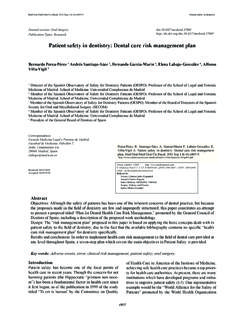Transcription of High-level principles for business continuity - August 2006
1 Basel Committee on Banking Supervision The Joint Forum High-level principles for business continuity August 2006. Requests for copies of publications, or for additions/changes to the mailing list, should be sent to: Bank for International Settlements Press & Communications CH-4002 Basel, Switzerland E-mail: Fax: +41 61 280 9100 and +41 61 280 8100. Bank for International Settlements 2006. All rights reserved. Brief excerpts may be reproduced or translated provided the source is stated. ISBN print: 92-9131-722-5.
2 ISBN web: 92-9197-722-5. THE JOINT FORUM. BASEL COMMITTEE ON BANKING SUPERVISION. INTERNATIONAL ORGANIZATION OF SECURITIES COMMISSIONS. INTERNATIONAL ASSOCIATION OF INSURANCE SUPERVISORS. C/O BANK FOR INTERNATIONAL SETTLEMENTS. CH-4002 BASEL, SWITZERLAND. High-level principles for business continuity August 2006. Table of contents Background and context ..5. Effective business continuity The benefits of High-level principles ..8. Target audiences ..9. Financial industry participants ..9. Financial authorities.
3 10. High-level principles for business continuity ..11. Principle 1: Board and senior management responsibility ..12. Principle 2: Major operational disruptions ..13. Principle 3: Recovery objectives ..14. Principle 4: Principle 5: Cross-border Principle 6: Principle 7: business continuity management reviews by financial authorities ..18. Annex I: Case Study: US-Canadian electrical power grid outages in August 2003 ..19. Annex II: Case study: The impact of the 2003 SARS outbreak on Hong Kong SAR's securities markets.
4 23. Annex III: Case Study: The impact of the 2003 SARS outbreak on the Canadian securities industry ..27. Annex IV: Case study: Niigata Chuetsu Annex V: Case Study: The London terrorist attacks on 7 July 2005 ..33. Annex VI: Bibliography ..36. Annex VII: Members of the Joint Forum business continuity Working Group ..38. Glossary Alternate site A site held in readiness for use during a business continuity event to maintain an organisation's business continuity . The term applies equally to work space or technology requirements.
5 Organisations may have more than one alternate site. In some cases, an alternate site may involve facilities that are used for normal day-to-day operations but which are able to accommodate additional business functions when a primary location becomes inoperable. Examples of alternate sites include relocation and disaster recovery sites, whether managed directly or maintained by a third party for an organisation's exclusive use or for use by multiple organisations. business continuity A state of continued, uninterrupted operation of a business .
6 business continuity A whole-of- business approach that includes policies, standards, and management procedures for ensuring that specified operations can be maintained or recovered in a timely fashion in the event of a disruption. Its purpose is to minimise the operational, financial, legal, reputational and other material consequences arising from a disruption. business continuity plan A component of business continuity management. A business continuity plan is a comprehensive written plan of action that sets out the procedures and systems necessary to continue or restore the operation of an organisation in the event of a disruption.
7 business impact analysis A component of business continuity management. business impact analysis is the process of identifying and measuring (quantitatively and qualitatively) the business impact or loss of business processes in the event of a disruption. It is used to identify recovery priorities, recovery resource requirements, and essential staff and to help shape a business continuity plan. Communication protocols Established procedures for communicating that are agreed in advance between two or more parties internal or external to an organisation.
8 Such procedures typically include the methodology for transmitting, writing, and reading of data (eg e-mails and intranet for employees, teleconferences or meetings with identified internal or external parties, and press releases, website postings, or news conferences for the public or other external stakeholders). Such procedures also typically include the nature of information that should be shared with various internal and external parties and how certain types of information should be treated (eg public or non-public), High-level principles for business continuity 1.
9 Critical market participants Participants in financial markets that perform critical operations or provide critical services. Their inability to perform such operations or provide such services for their own or others' benefit could pose a significant risk of major disruption to the continued operation of individual participants or the financial system. Critical operation or service Any activity, function, process, or service, the loss of which would be material to the continued operation of the financial industry participant, financial authority, and/or financial system concerned.
10 Whether a particular operation or service is critical depends on the nature of the relevant organisation or financial system. Data centre operations are an example of critical operations to most financial industry participants. Examples of critical services to financial systems include, but are not limited to, large value payment processing, clearing and settlement of transactions, and supporting systems such as funding and reconciliation services. Emergency response An organisation responsible for responding to hazards to the general organisation population (eg fire department, police services).














